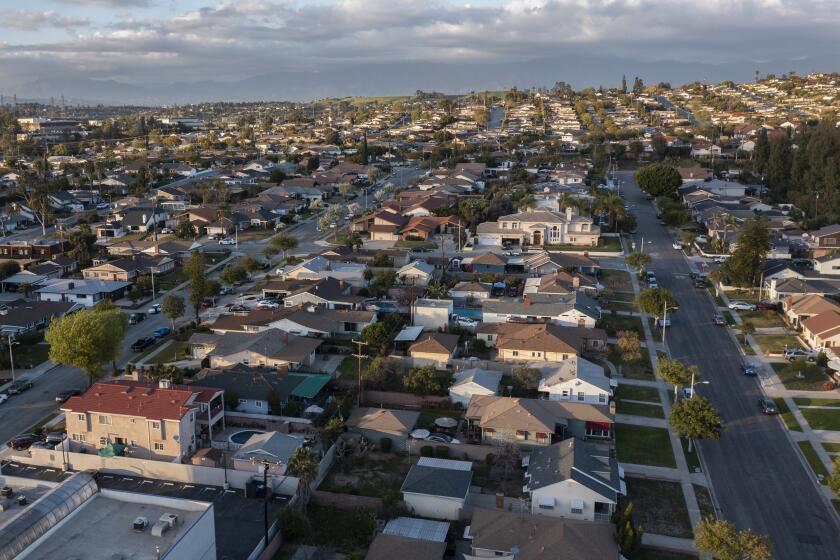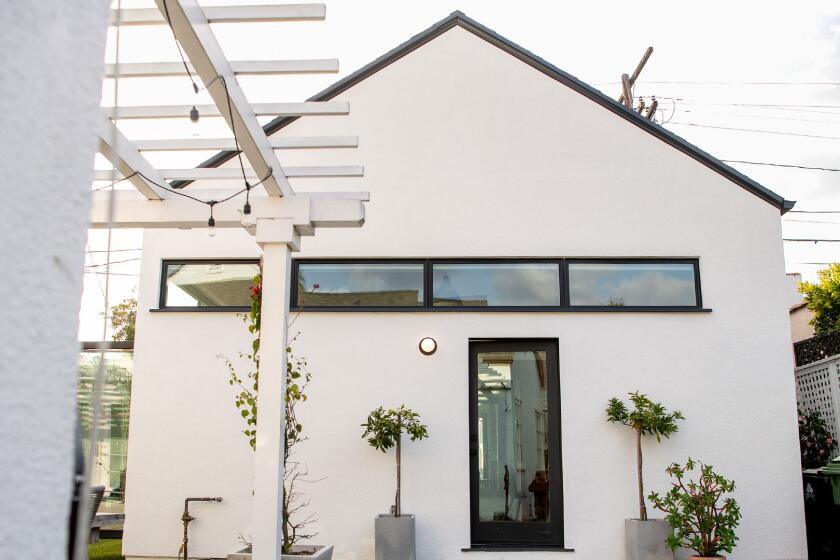This California city is letting owners sell ADUs as starter homes. Will it be a housing revolution?

Accessory dwelling units are multiplying across California, boosted by permissive state laws that aim to increase the supply of affordable housing.
Now, a handful of cities are moving to let homeowners sell their backyard cottages and converted garages separately from the houses they live in, potentially transforming ADUs into a new generation of starter homes that cost a fraction of a full-sized house on a full-sized lot. The first to act was the San José City Council, which approved an ordinance Tuesday authorizing the separate sale of ADUs as of mid-July.
Housing advocates say that Sacramento and Berkeley are also working on measures to allow separate sales of ADUs, and San Diego County is exploring it. Local governments were given the authority to do so last year under Assembly Bill 1033, which also laid out the process homeowners must follow to sell their ADU without selling the land it’s sitting on.
Supporters of AB 1033 say ADUs can help fill a gaping hole in the state’s housing supply when it comes to entry-level housing, a problem exacerbated by high mortgage interest rates. “The majority of the state is unable to afford the majority of homes on the market,” said Rafael Perez, president of the board of the Casita Coalition, a nonprofit coalition that promotes housing solutions.
Starting about seven years ago, California lawmakers steadily removed ADU construction barriers imposed by local governments, going so far as to give homeowners the right to build at least one unit that met some standard requirements. The dwellings, which are usually 600 to 1,200 square feet, have all the basic features of a single family home but are far less expensive to build because there is no additional cost for land.
You Do ADU, a six-part series, will guide you through the decisions about whether and how to build an accessory dwelling unit in Southern California.
Since state lawmakers began promoting ADUs, interest has exploded. In L.A. County alone, nearly 60,000 permits for ADUs have been issued since 2018.
The requirement that ADUs be on the same lot as the primary residence, however, has prevented them from being sold separately. Under AB 1033, local governments can solve that problem by allowing homeowners to treat their house and ADU as condominiums, with shared obligations but separate titles.
“This creates an opportunity for new [housing] inventory that is much easier to build,” Perez said. That’s particularly important now, he said, because high interest rates are making houses less affordable and cutting down the number of units on the market, as some homeowners balk at the cost of a loan for a new home.
Perez said that California is the only state that has banned the separate sale of ADUs. “What we’ve seen in other states is that the ADU tends to sell for 40% to 60% of what a single family home in that neighborhood will sell for,” he said.
Meredith Munger, a loan officer at CrossCountry Mortgage in San Diego, estimated that 60% of her customers are building ADUs for family members, and more than half of those want to sell the unit to those relatives. With such a sale, the homeowner would no longer be responsible for the debt incurred in building the ADU, and the relatives would be able to build an equity stake.
“In other states, approximately 50% of ADUs are sold, particularly to young families,” Munger said. “Most of these ADUs are sold by retirees who have long ago paid off their house but don’t want to take care of a large backyard.”
Tens of thousands of ADUs in California are believed to be unpermitted. Here’s how to go about bringing one up to code and into compliance.
Selling an ADU can also provide a boost to one’s retirement income, she said. Alternatively, some retirees are moving into their ADUs and selling “the big front house that they don’t want to maintain.”
Some advocates predicted that implementing AB 1033 could encourage more people to build ADUs. Roberto Barrágan, executive director of the California Community Economic Development Assn., said one of the primary benefits is that it would make it easier to finance the construction and purchase of an ADU.
The potential for two home sales on a single lot may also give investors more incentive to build and sell an ADU along with the homes they flip, Perez said. But he noted that when a house and ADU are sold separately, the house typically goes for less than the market value of single family homes without separate ADUs.
This isn’t necessarily an issue for the homeowner who builds an ADU; the extra value created by the ADU will more than make up for any reduction in the sale price of the house. But the buyer of the house will be left with a smaller lot, a close neighbor and a property covered by a homeowners association agreement.
Some skeptics say converting the house and ADU on your lot into condos would not be quick, easy or cheap.
Paul Dashevsky and Jon Grishpul, owners of home improvement sites GreatBuildz and Maxable, said a homeowner going through the process probably will require an attorney, a surveyor and a civil engineer. People will also have to consider what it will mean to create a homeowners association for their house and the ADU, they said.
“It’s probably a yearlong process. Nobody knows yet,” Dashevsky said. Grishpul said service providers may need to emerge in California to handle the paperwork burdens for homeowners, as they have in places like Seattle that already have gone this route.
The HOA would cover the operating and maintenance costs of any shared spaces and utilities, such as water and sewer lines, which could translate into monthly fees. Its covenants, conditions and restrictions could also set rules for such things as the appearance of the property and its structures, although future owners of the house and the ADU could agree to amend them.
California homeowners have the right to build at least two ADUs on their property. But naturally, there are rules and costs. Here’s a guide.
The city and county of Los Angeles have taken no formal steps to implement AB 1033, and officials did not respond immediately to requests for comment. Perez said the cities of Glendale and Pasadena opposed the measure when it was in the Legislature.
He added that a handful of local governments across the state “have seen the urgency of the situation that we’re in” and are moving ahead on AB 1033. But a lot of others, he said, are saying, “Let’s wait and see what other cities do and kind of see how it shakes out.”
More to Read
Sign up for This Evening's Big Stories
Catch up on the day with the 7 biggest L.A. Times stories in your inbox every weekday evening.
You may occasionally receive promotional content from the Los Angeles Times.














![[20060326 (LA/A20) -- STATING THE CASE: Marchers organized by unions, religious organizations and immigrants rights groups carry signs and chant in downtown L.A. "People are really upset that all the work they do, everything that they give to this nation, is ignored," said Angelica Salas of the Coalition of Humane Immigrant Rights. -- PHOTOGRAPHER: Photographs by Gina Ferazzi The Los Angeles Times] *** [Ferazzi, Gina -- - 109170.ME.0325.rights.12.GMF- Gina Ferazzi/Los Angeles Times - Thousands of protesters march to city hall in downtown Los Angeles Saturday, March 25, 2006. They are protesting against House-passed HR 4437, an anti-immigration bill that opponents say will criminalize millions of immigrant families and anyone who comes into contact with them.]](https://ca-times.brightspotcdn.com/dims4/default/34f403d/2147483647/strip/true/crop/1983x1322+109+0/resize/840x560!/quality/75/?url=https%3A%2F%2Fcalifornia-times-brightspot.s3.amazonaws.com%2Fzbk%2Fdamlat_images%2FLA%2FLA_PHOTO_ARCHIVE%2FSDOCS%2854%29%2Fkx3lslnc.JPG)